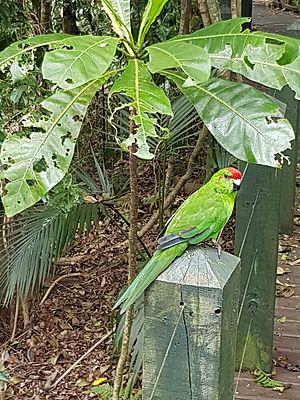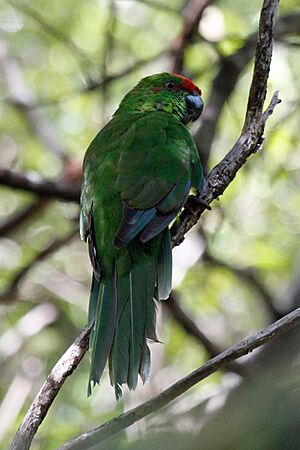Norfolk parakeet facts for kids
Quick facts for kids Norfolk parakeet |
|
|---|---|
 |
|
| On Norfolk Island, Australia | |
| Conservation status | |
| Scientific classification | |
| Genus: |
Cyanoramphus
|
| Species: |
cookii
|
| Synonyms | |
|
|
The Norfolk parakeet (Cyanoramphus cookii) is a type of parrot. It is also known as the Tasman parakeet, Norfolk Island green parrot, or Norfolk Island red-crowned parakeet. This special bird lives only on Norfolk Island. This island is found in the Tasman Sea, between Australia, New Zealand, and New Caledonia.
Contents
About the Norfolk Parakeet
The Norfolk parakeet was first described in 1859 by a scientist named George Robert Gray. He named it Platycercus Cookii. The name honors Captain James Cook, who saw these birds on Norfolk Island in 1774. He noticed they looked like birds from New Zealand.
For a long time, people thought the Norfolk parakeet was just a type of Red-crowned parakeet from New Zealand. But scientists like Alfred North and Graeme Phipps noticed it was much bigger. In 2001, DNA tests showed that the Norfolk parakeet is quite different. It split off very early from other parakeets in its group. Only the New Caledonian parakeet and Chatham parakeet are more different.
The official name for this bird is "Norfolk parakeet." This name was chosen by the International Ornithologists' Union. People on Norfolk Island sometimes call it the green parrot. Another name, "Tasman parakeet," is used by some scientists. They think this bird and the Lord Howe red-crowned parakeet might be the same species. This is because they live in similar areas around the Tasman Sea. However, more studies are needed to be sure.
Where They Live and What They Eat
The Norfolk parakeet used to live all over Norfolk Island. But by 1908, it could only be found in the forests around Mount Pitt. This area is in the northwestern part of the island. Its natural home is the native rainforest. But it also flies into nearby plantations and fruit orchards to find food.
Seeds make up more than half of the Norfolk parakeet's diet. This is especially true in winter. They mostly eat seeds from five types of plants. These include the Norfolk pine (Araucaria heterophylla) and the niau palm (Rhopalostylis baueri). They also eat seeds from the ake ake (Dodonaea viscosa). Some of their food comes from plants that were brought to the island, like the African olive (Olea europaea'' subsp. ''cuspidata'']) and cherry guava (Psidium cattleyanum).
Threats and Conservation Efforts
The Norfolk parakeet was once a common bird. But by the late 1970s, there were fewer than 50 birds left. Many things caused their numbers to drop. One big problem was losing their homes. This included losing large, old trees where they could build nests. Rats and cats also killed their eggs and young birds. Early settlers sometimes shot the birds. Other birds, like crimson rosellas and common starlings, also competed for nesting spots.
In 1983, a program started to try and breed the birds in captivity. This program was not successful. However, it made people on Norfolk Island more interested in helping the birds.
From 1987 to 2000, a big effort was made to help the parakeets. People worked to reduce the number of rats and cats by trapping them. They also built special nesting boxes that rats could not get into. These efforts helped the parrot numbers grow. About 250 young birds successfully left their nests.
It was hard to count the exact number of Norfolk parakeets. Between 2009 and 2012, people worried that their numbers might be going down again. A count in 2009 estimated there were about 240 birds. Today, the Norfolk parakeet is mostly found in the Norfolk Island National Park and the areas around it.
Long ago, the brown goshawk used to hunt these parakeets. But this hawk disappeared from the island around 1790.
See also
 In Spanish: Perico de Norfolk para niños
In Spanish: Perico de Norfolk para niños



